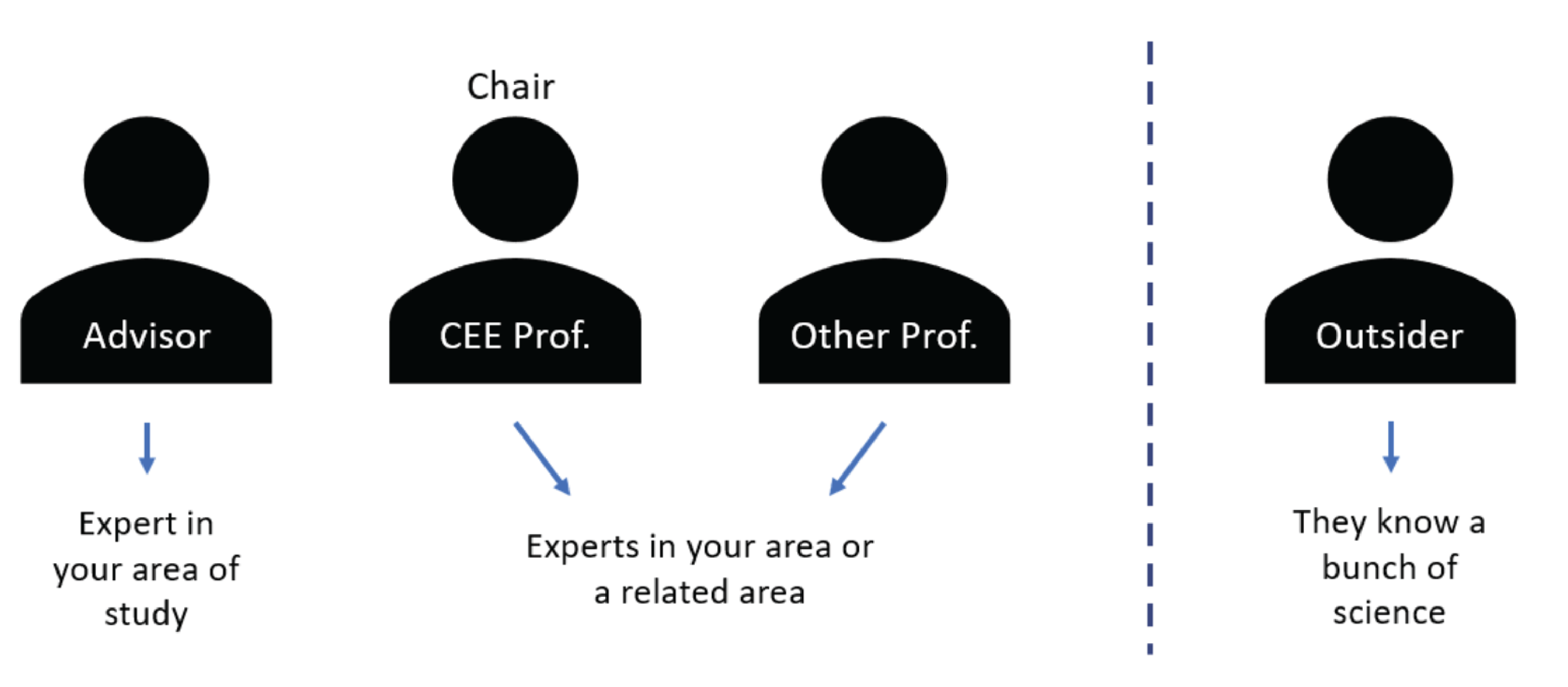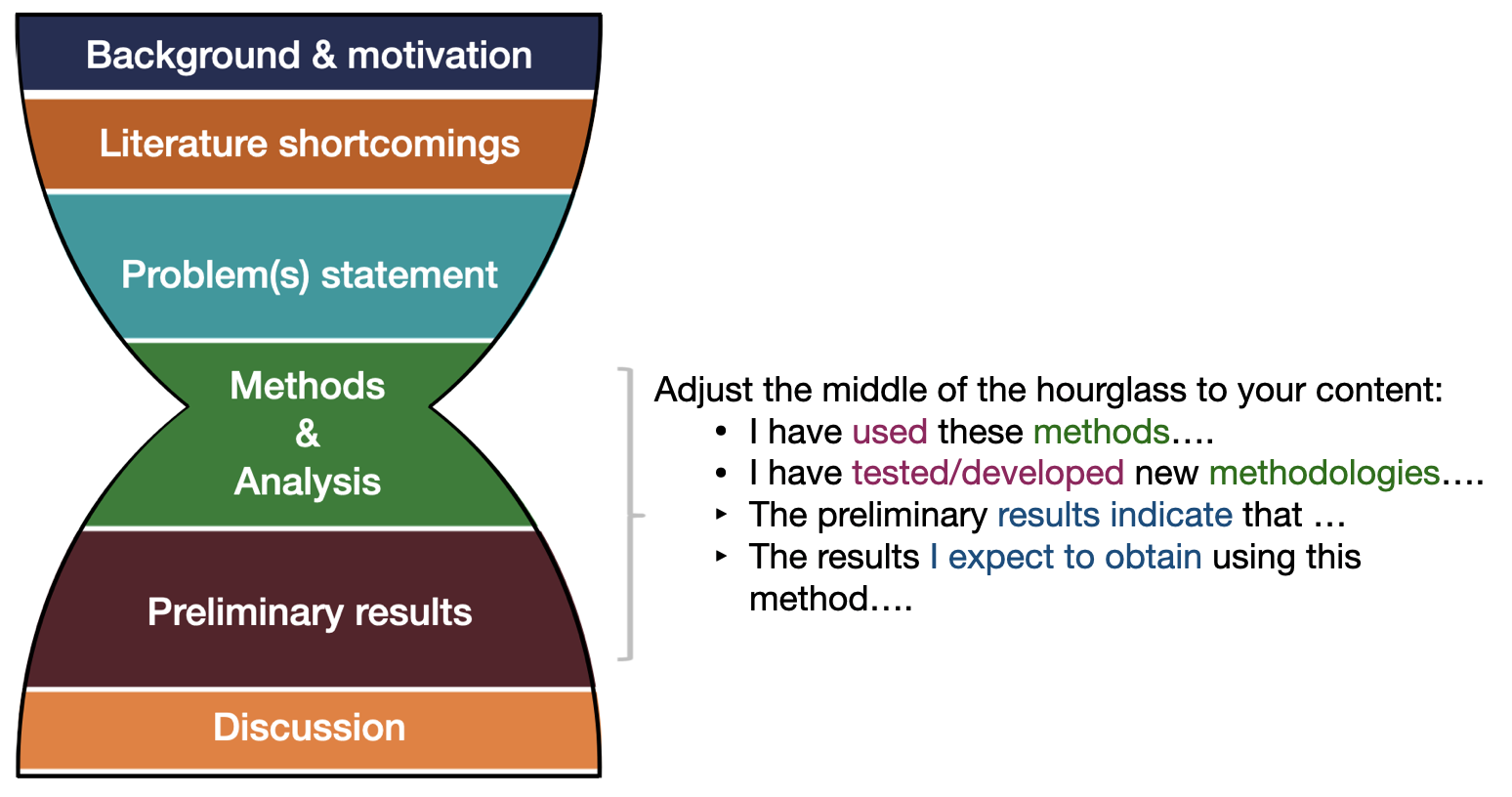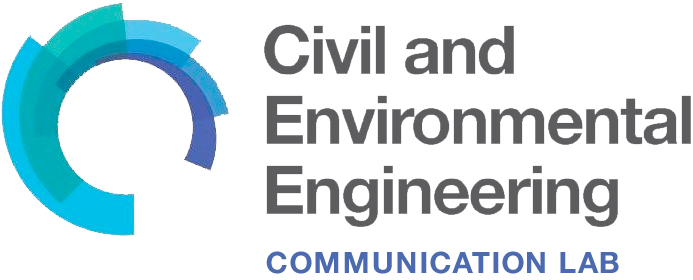By Souha El Mousadik, CEE Communication Fellow
This CommKit article focuses on the two main components of the CEE Qualifying Exam: 1) the research paper, and 2) the research presentation. The information in this article was compiled from the personal experiences of graduate students who successfully passed their Qualifying Exams, and from conversations with CEE faculty members.
Criteria for success
- Establish your project contribution to the general scientific discipline.
- Showcase research maturity and ingenuity with regards to formulating and solving problems.
- Highlight your research aptitude in establishing methods and conducting analysis.
Purpose and Expectations of the Qualifying Exam
Unlike the thesis proposal, the focus of this academic exercise is not about the significance of your research or the quality of your results. Instead you are invited to show that you possess the qualities necessary to complete a PhD by demonstrating:
- Your understanding of the research discipline
- Your ingenuity in approaching and solving unfamiliar problems
- Your ability to communicate your research to different audiences
In a survey distributed to graduate students preparing for the Qualifying Exams in 2023, respondents (n = 6) perceived the General Exam guidelines for the Research Paper and the Presentation to be equally obscure.

The CEE Doctoral program handbook only specifies that the research paper is “due 1 week before your scheduled presentation”, should have a “maximum of 10 pages, single-spaced, with 12-pt font” and should review research done to date. Further it indicates that you should plan a 30-minute presentation that covers the same content of your research paper. To complement these high-level guidelines, this article provides more in-depth instructions and information.
Know Your Audience
Unlike many of the papers and presentations you will produce during graduate school, for your qualifying exam only a select few a priori known faculty members (i.e. your exam committee) will read your research proposal and attend your presentation. This is one of the rare occasions when you can tailor the content of your message to your specific audience.
 Your qualifying exam committee will mostly be composed of professors (including your advisor) specializing in your chosen subject area. They are likely familiar with the broader field, but not your specific problem. You must keep your content accessible to everyone in your committee by using effective science communication practices. This includes defining unfamiliar concepts, technical jargon, and acronyms specific to your subject area. If you are unsure of your audiences’ specific expertise and/or expectations, err on the side of caution, and make sure any technical concepts are properly explained. Regardless, during the exam, your committee is not judging the value or novelty of your research topic, instead the focal point is your capacity as a researcher.
Your qualifying exam committee will mostly be composed of professors (including your advisor) specializing in your chosen subject area. They are likely familiar with the broader field, but not your specific problem. You must keep your content accessible to everyone in your committee by using effective science communication practices. This includes defining unfamiliar concepts, technical jargon, and acronyms specific to your subject area. If you are unsure of your audiences’ specific expertise and/or expectations, err on the side of caution, and make sure any technical concepts are properly explained. Regardless, during the exam, your committee is not judging the value or novelty of your research topic, instead the focal point is your capacity as a researcher.
Structure Your Content
It is recommended that you follow the standard ‘hourglass’ concept as the basic organizational unit of scientific writing and presentation.

Introduction
- Set up the general background: Anchor your research in a general topic the audience cares about. For example, “Understanding hydraulic fracturing is important to enhance wellbore productivity in industries like unconventional oil and gas and geothermal energy.”
- State the problem to be addressed: Orient the audience by linking the general topic to a specific issue within your area of focus. For example, “Initiation and propagation of hydraulic fractures are affected by certain parameters.”
- Identify knowledge gaps: Highlight the shortcomings of the current understanding and state the problem at hand. For example, “Fracture initiation and propagation patterns could not be observed during the experiments in prior studies.”
- Present methodologies and (expected) results: Briefly present the methods undertaken and the preliminary results, or the strongest conjectures you might expect. For example, “I propose to directly observe fluid penetration during experiments with the use of high speed imaging and transparent walls at constant parameters.”
When writing the research paper, you will probably want to tackle the introduction once the Methods and Results sections are drafted. These two sections will determine how you connect the “Here I show’’ final part of your introduction to the body of your paper.
After reading your Introduction, the audience must have all the tools necessary to understand your approach and the (expected) results. Take the time to familiarize the committee with all key terms, acronyms, and technical jargon. Consider asking a friend in a different lab (or a Fellow in the Comm Lab) to read over your Introduction and point out any obscure terms that should be clearly defined.
Methods
The Methods section allows you to describe how you will tackle the research question posed in the introduction. Unlike a classic technical presentation, in this exam you are expected to place more weight on methods and less on results. More specifically, you are expected to provide reasoning for your chosen methods and demonstrate that you have performed the necessary controls and sensitivity analysis. If some elements in your methods only appeal to experts in your field (i.e. your advisor and another CEE professor working in your field), remember to explain underlying physical notions. Make sure to introduce acronyms relevant to your methodology of choice, and take the time to describe the materials and instruments you employed (or developed). Be sure to cite reference papers for standard methods you employed, but always highlight any elements or steps that you may have altered. Remember that the Methods section is key in assessing the validity and repeatability of your results. This is fundamental in scientific writing even beyond this exam.
While figures in your research paper may include multiple concepts at once, figures in your presentation need to act as visual evidence to support the claim purported in your slide. Likewise, while it may be easy to narrate certain elements of your methodology in your research paper, it may be more appropriate to illustrate certain aspects with appropriate schematics in your presentation instead.
Results
In the Results section, the data obtained thus far with the methods employed are presented in an objective manner and in a narrative form. This section serves as support for the interpretation of the data presented in your figures, by drawing attention to important features and trends, and linking to experimental events.
Discussion
Whether or not you have results, you are still expected to succinctly link your (expected) results to your motivation and research question posed in your introduction. Don’t panic if you don’t have ‘results’ yet, you can illustrate or sketch what you expect your findings to be and how they might compare to existing literature, as shown in the images below.

The discussion section allows you to break down meaningful data patterns and offer your interpretation. Here you can contrast your findings to works in literature: Are your results similar? Why or why not? Are there new emerging trends that haven’t been reported yet? What are the implications of your findings?
This is also your opportunity to bring up any limitations that may influence or restrict the scope of your results. Is the number of data sets you have collected so far insufficient? Do you plan to take more? Are there any inadequacies of the methodology itself? Do you need to think of other approaches to tackle unresolved questions?
Tips and Cautionary Tales for the Presentation
Plan your 30-minute research presentation in a cohesive and logical manner, and be highly selective with the content you choose to include. Do not overwhelm your audience with superfluous information by forcefully including all the work that you have performed so far. Your exam committee trusts that you have been busy working on your research. Avoid narrations of origin stories or showcasing your material as a chronological record of your research activities. Use the appropriate material to guide your research narrative and showcase selected information that highlights your research skills.
Ahead of your presentation, get comfortable with using the pronoun ‘I’ instead of the usual ‘we’. It is in fact expected of you to highlight and separate your individual contributions from those of your group. Unlike the technical presentations within the academic environment, this is one of the rare occasions where you are presenting your research representing yourself, and not your research group.
Finally, you should expect that some of the questions from the committee may lead you down a few detours along the way, which you should be prepared to tackle in a confident and collected manner. However, you should remain vigilant to not let these questions derail the entire presentation flow, and be confident to steer the conversation back to your topic of focus. For additional tips, you can check out this CommKit article on Handling the Q&A Session of the exam.
*******************
Additional resources
Check out the full collection of free CommKit Resources created by the MIT CEE Comm Lab team.
For more in-depth information on visual communication, including data and figure design, here are many great resources the Fellows have found helpful:
Nature “Points of View” series
- Layout: Arranging text and images according to an overall aesthetic scheme
- Axes, ticks and grids: Make navigational elements distinct and unobtrusive to maintain visual priority of data.
- Plotting symbols: Choose distinct symbols that overlap without ambiguity and communicate relationships in data.
- Color coding: A systematic approach to choosing colors that are discriminable.
- Mapping quantitative data to color: Data structure informs choice of color maps.
Libraries for data visualization
- The data visualization catalog library of different information visualization types (inspiration resource)
- Choosing the right chart type for your data
- Fundamentals of Data Visualization: website for the book “Fundamentals of Data Visualization,” published by O’Reilly Media, Inc.
- Rules for Better Figures: basic set of rules to improve figure design and to explain some of the common pitfalls.
- Effective graphical displays: an abbreviated version of Jean-luc Doumont book chapters
- Data Visualization: A practical introduction: basic principles behind effective data visualization (Bonus: hands-on introduction to the principles and practice of looking at and presenting data using R and ggplot)
- Creating publication-quality figures: guide for generating figures with softwares that are free and open source (Bonus tutorials)
- Picking a color scale for scientific graphics: recommendations for making scientific graphics and choice of color palette
Visualization software and tools
- Plotting and data visualization: Excel, MATLAB, Python, R, Latex graphicx, ImageJ, Tableau*, (blog with tutorials)
- 2D+3D Computer Aided Design tools: Photoshop, Illustrator, Premiere Pro, Animate, DaVinci, Inkscape, AutoCAD, SketchUp, SolidWorks, Rhino*
- Chemistry specific tools: Chemdraw, PyMOL, Chemix
- Biology specific tools: bioRender*, Mind the Graph
- Choosing colors and map colors
- ColorBrewer: Web tool for guidance in choosing map color schemes, based on the research of Dr. Cynthia Brewer
- CoBlis – Color Blindness Simulator
- Gradient Generators
- Palette Generat
